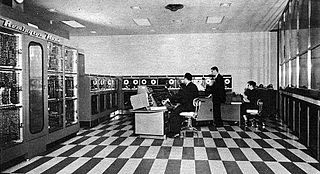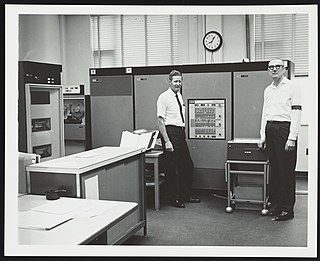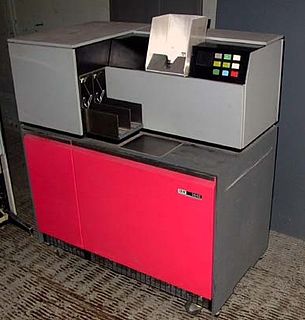
The IBM System/360 (S/360) is a family of mainframe computer systems that was announced by IBM on April 7, 1964, and delivered between 1965 and 1978. It was the first family of computers designed to cover both commercial and scientific applications and to cover a complete range of applications from small to large. The design distinguished between architecture and implementation, allowing IBM to release a suite of compatible designs at different prices. All but the only partially compatible Model 44 and the most expensive systems use microcode to implement the instruction set, which features 8-bit byte addressing and binary, decimal, and hexadecimal floating-point calculations.

Punched tape or perforated paper tape is a form of data storage that consists of a long strip of paper in which holes are punched. It developed from and was subsequently used alongside punched cards, differing in that the tape is continuous.

The IBM 1620 was announced by IBM on October 21, 1959, and marketed as an inexpensive scientific computer. After a total production of about two thousand machines, it was withdrawn on November 19, 1970. Modified versions of the 1620 were used as the CPU of the IBM 1710 and IBM 1720 Industrial Process Control Systems.

UNIVAC was a line of electronic digital stored-program computers starting with the products of the Eckert–Mauchly Computer Corporation. Later the name was applied to a division of the Remington Rand company and successor organizations.

In computing, spooling is a specialized form of multi-programming for the purpose of copying data between different devices. In contemporary systems, it is usually used for mediating between a computer application and a slow peripheral, such as a printer. Spooling allows programs to "hand off" work to be done by the peripheral and then proceed to other tasks, or to not begin until input has been transcribed. A dedicated program, the spooler, maintains an orderly sequence of jobs for the peripheral and feeds it data at its own rate. Conversely, for slow input peripherals, such as a card reader, a spooler can maintain a sequence of computational jobs waiting for data, starting each job when all of the relevant input is available; see batch processing. The spool itself refers to the sequence of jobs, or the storage area where they are held. In many cases, the spooler is able to drive devices at their full rated speed with minimal impact on other processing.

The IBM 1130 Computing System, introduced in 1965, was IBM's least expensive computer at that time. A binary 16-bit machine, it was marketed to price-sensitive, computing-intensive technical markets, like education and engineering, succeeding the decimal IBM 1620 in that market segment. Typical installations included a 1 megabyte disk drive that stored the operating system, compilers and object programs, with program source generated and maintained on punched cards. Fortran was the most common programming language used, but several others, including APL, were available.

The IBM 1800 Data Acquisition and Control System (DACS) was a process control variant of the IBM 1130 with two extra instructions, extra I/O capabilities, 'selector channel like' cycle-stealing capability and three hardware index registers.

The IBM System/3 was an IBM midrange computer introduced in 1969, and marketed until 1985. It was produced by IBM Rochester in Minnesota as a low-end business computer aimed at smaller organizations that still used IBM 1400 series computers or unit record equipment. The first member of what IBM refers to as their "midrange" line, it also introduced the RPG II programming language. It is the first ancestor in the product line whose current version is the IBM i series and includes the highly successful AS/400.

The Teletype Model 33 is an electromechanical teleprinter designed for light-duty office use. It is less rugged and cost less than earlier Teletype machines. The Teletype Corporation introduced the Model 33 as a commercial product in 1963 after being originally designed for the United States Navy. There are three versions of the Model 33:

The UNIVAC 1050 was a variable word-length decimal and binary computer.
A computer operator is a role in IT which oversees the running of computer systems, ensuring that the machines, and computers are running properly. The job of a computer operator as defined by the United States Bureau of Labor Statistics is to "monitor and control ... and respond to ... enter commands ... set controls on computer and peripheral devices. This Excludes Data Entry."

The NCR 315 Data Processing System, released in January 1962 by NCR, is a second-generation computer. All printed circuit boards use resistor–transistor logic (RTL) to create the various logic elements. It uses 12-bit slab memory structure using magnetic-core memory. The instructions can use a memory slab as either two 6-bit alphanumeric characters or as three 4-bit BCD digits. Basic memory is 5000 "slabs" of handmade core memory, which is expandable to a maximum of 40,000 slabs in four refrigerator-size cabinets. The main processor includes three cabinets and a console section that houses the power supply, keyboard, output writer, and a panel with lights that indicate the current status of the program counter, registers, arithmetic accumulator, and system errors. Input/Output is by direct parallel connections to each type of peripheral through a two-cable bundle with 1-inch-thick cables. Some devices like magnetic tape and the CRAM are daisy-chained to allow multiple drives to be connected.
The Houston Automatic Spooling Priority Program, commonly known as HASP, is an extension of the IBM OS/360 operating system and its successors providing extended support for "job management, data management, task management, and remote job entry."
The IBM 2780 and the IBM 3780 are devices developed by IBM to perform remote job entry (RJE) and other batch functions over telephone lines; they communicate with the mainframe via Binary Synchronous Communications and replaced older terminals using synchronous transmit-receive (STR). In addition, IBM has developed workstation programs for the 1130, 360/20, 2922, System/360 other than 360/20, System/370 and System/3.

A computer punched card reader or just computer card reader is a computer input device used to read computer programs in either source or executable form and data from punched cards. A computer card punch is a computer output device that punches holes in cards. Sometimes computer punch card readers were combined with computer card punches and, later, other devices to form multifunction machines. It is a input device and also an output device. Most early computers, such as the ENIAC, and the IBM NORC, provided for punched card input/output. Card readers and punches, either connected to computers or in off-line card to/from magnetic tape configurations, were ubiquitous through the mid-1970s.

The IBM System/360 Model 20 is the smallest member of the IBM System/360 family announced in November 1964. The Model 20 supports only a subset of the System/360 instruction set, with binary numbers limited to 16 bits and no floating point. In later years it would have been classified as a 16-bit minicomputer rather than a mainframe, but the term "minicomputer" was not current, and in any case IBM wanted to emphasize the compatibility of the Model 20 rather than its differences from the rest of the System/360 line. It does, however, have the full System/360 decimal instruction set, that allows for addition, subtraction, product, and dividend of up to 31 decimal digits.
The IBM 2922 Programmable Terminal is a Remote Job Entry (RJE) terminal introduced by IBM in 1972. The 2922 communicated using Binary Synchronous Communications (Bisync).
Attached Support Processor (ASP) was an implementation of loosely coupled multiprocessing for IBM's OS/360 operating system. IBM later changed the name to Asymmetrical multiProcessor but retained the acronym ASP.

The IBM System/360 Model 25 is a low-end member of the IBM System/360 family. It was announced on January 3, 1968, 3 years before the IBM System/360 Model 22, as a "bridge between its old and new computing systems".















